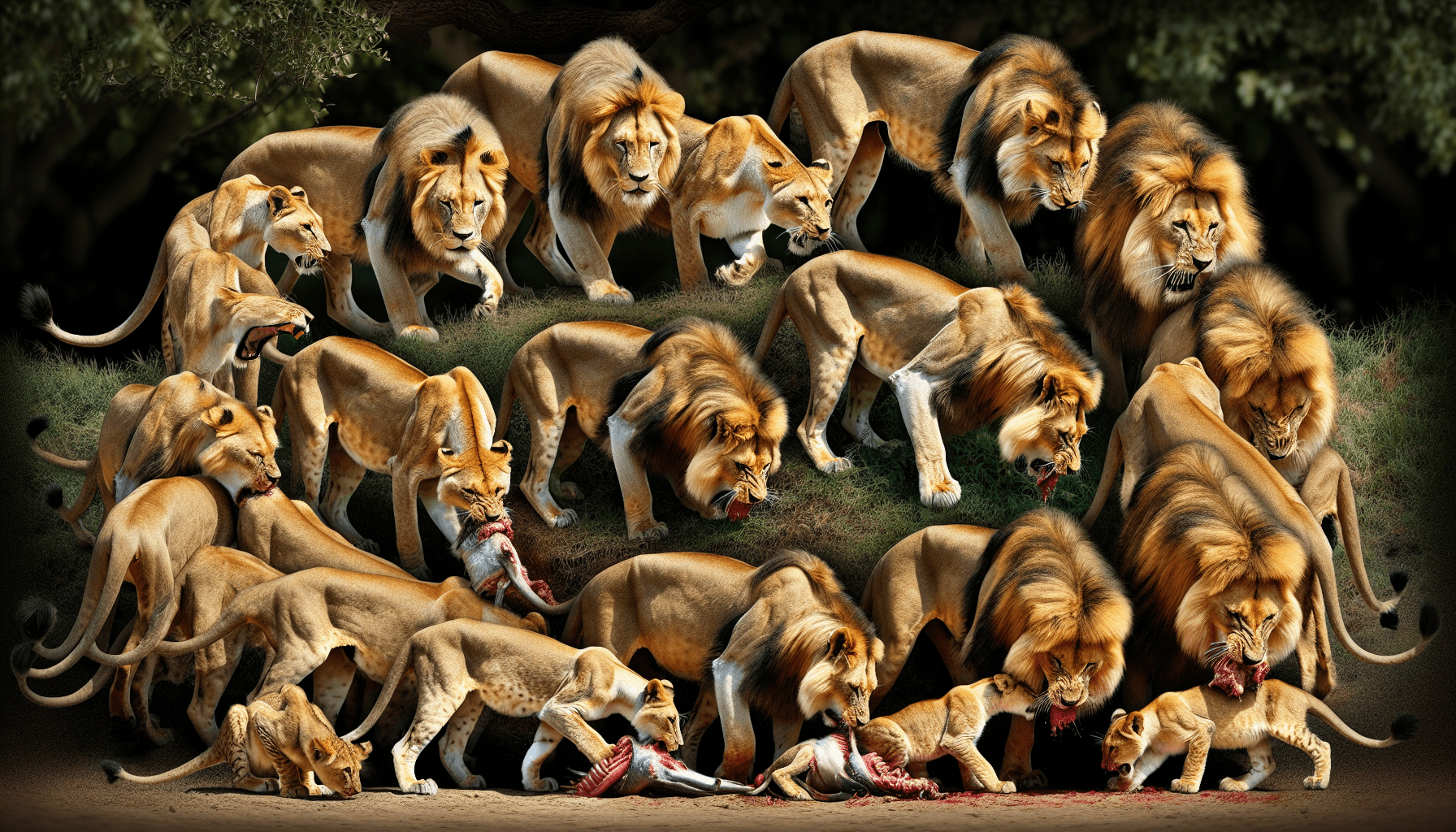So you’ve always wondered what lions do with their prey after a successful hunt, right? Well, you might be surprised to learn that lions don’t necessarily devour their prey all at once. In fact, they have a somewhat strategic approach to their meals. Instead of gobbling it all up in one sitting, lions often opt for a more practical approach, dragging the carcass to a safe location and consuming it over the course of a few days. This behavior not only allows them to maximize their meal’s nutritional value but also ensures their survival in an unpredictable environment. Curious to know more about the fascinating dining habits of these majestic creatures? Let’s dive right in!
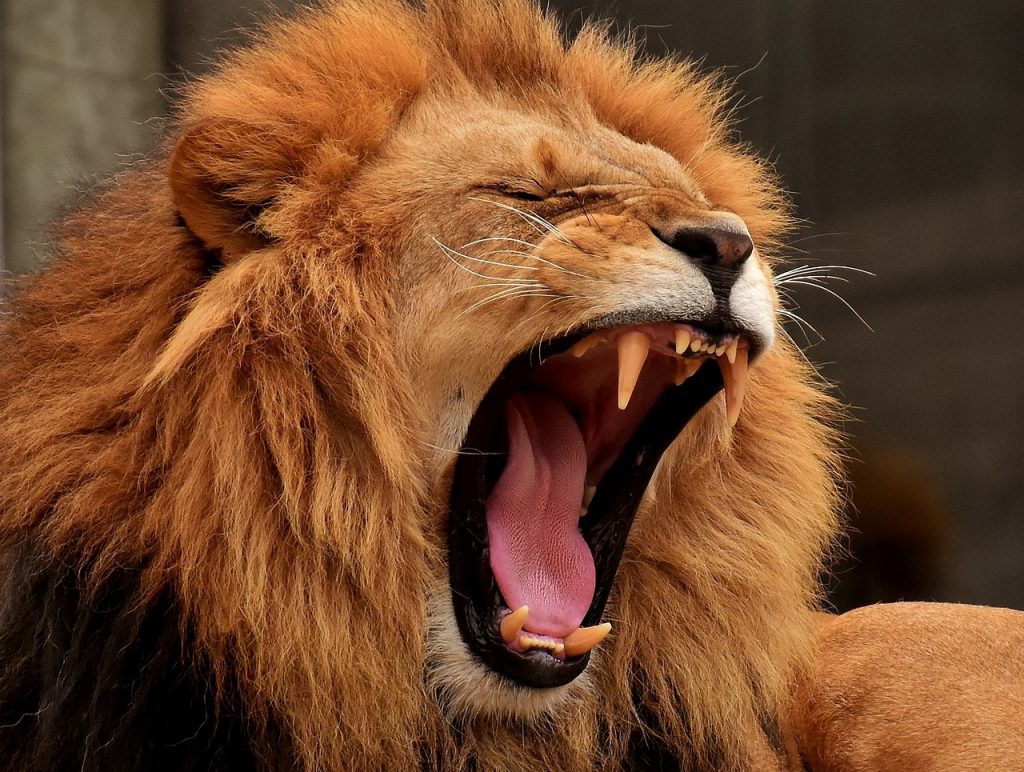
Eating Behavior of Lions
Hunting and Killing Prey
Lions are highly skilled predators known for their hunting prowess. They employ various strategies and techniques to successfully capture and kill their prey. Hunting for lions is an essential activity as it provides them with the necessary sustenance to survive and thrive in their natural habitats.
Feeding as a Group
Lions are unique among big cats as they exhibit a social structure and engage in cooperative hunting. They form prides consisting of several related females, their offspring, and a small number of dominant males. This social structure enables them to hunt together as a group, increasing their chances of successful kills.
During feeding, lions have a well-defined hierarchy within the pride. The dominant males and females have the first access to the prey, followed by the younger members. This feeding hierarchy ensures that each lion gets a fair share of the meal, preventing conflict within the pride.
Types of Prey Consumed
Lions have a diverse diet and consume a wide range of prey species. They primarily target large herbivores such as zebras, wildebeests, and buffalo. These ungulates provide a substantial amount of meat for the lions, sustaining them for extended periods.
In addition to large herbivores, lions also prey on smaller animals such as gazelles, impalas, and warthogs. These smaller prey species supplement their diet and provide additional sources of nutrition.
Quantities of Food Consumed
The amount of food a lion consumes depends on various factors, including the size and age of the individual, as well as the availability of prey. On average, an adult lion can consume around 15% of its body weight in a single meal.
Lions have the ability to eat large quantities of meat in one sitting, allowing them to stock up on nutrients that may not be available for a considerable period. This enables them to endure times of scarcity and survive in challenging environments.
Scavenging Behavior
While lions are primarily apex predators, they also exhibit scavenging behavior. They often scavenge on carcasses left behind by other predators or scavengers. Scavenging provides an additional source of food for lions when hunting is not successful or during times of food scarcity.
Lions are known to interact with other scavengers, such as hyenas and vultures. They often face competition for carcasses and must assert their dominance to secure a share of the food. Scavenging behavior allows lions to adapt and survive in unpredictable environments.
Hunting and Killing Prey
Hunting Strategies
Lions employ various hunting strategies depending on the type of prey and the terrain they are in. One common strategy is stalking, where lions silently approach their target by using surrounding vegetation for cover. This technique allows them to get close to their prey without being detected.
Another strategy utilized by lions is chasing. They can reach speeds of up to 50 miles per hour in short bursts, enabling them to sprint after their chosen prey. This strategy is particularly effective when targeting swifter animals such as gazelles or impalas.
Ambushing Techniques
Lions are also skilled ambush predators. They carefully position themselves near watering holes or areas where prey is likely to pass by. Once an unsuspecting animal gets close enough, the lion will swiftly pounce and deliver a lethal bite to the neck or throat of its prey.
Ambushing allows lions to conserve energy while maximizing their chances of a successful kill. It requires patience and precise timing, as they rely on the element of surprise to overpower their prey.
Coordinated Hunting
Lions are unique among big cats in their ability to coordinate their hunting efforts. They employ teamwork and cooperation to bring down larger prey. This is especially evident when hunting in the grasslands, where they can use their numbers to their advantage.
During a coordinated hunt, lions strategically position themselves to encircle the target, cutting off escape routes and overwhelming the prey with their sheer presence. This method increases their chances of a successful kill, as the prey finds it difficult to defend itself against multiple attackers.
Feeding as a Group
Social Structure and Feeding Hierarchy
Lions live in prides, which consist of several related females, their offspring, and a few dominant males. Within the pride, there is a well-defined social structure and feeding hierarchy. The dominant males and females have the highest priority during feeding, followed by the younger members.
The hierarchy ensures that the dominant lions have access to the best portions of the kill, while the others patiently wait their turn. This feeding system reduces conflict within the pride and promotes cooperation, ensuring that all members receive their fair share of the meal.
Sharing and Communication during Feeding
Feeding as a group also involves communication and sharing among pride members. Lions use various vocalizations and body postures to convey their intentions and maintain social cohesion during feeding. Growls, roars, and other vocalizations serve as signals to establish dominance or warn others to keep their distance.
Lions also engage in mutual grooming and rubbing against each other’s bodies as a form of bonding and reaffirming social ties. These behaviors promote a sense of unity and cooperation within the pride, enhancing their overall feeding success.
Competition over Prey
Feeding as a group can lead to competition among pride members, especially when the available prey is limited. Dominant individuals may try to monopolize the kill, leading to conflicts and disputes within the pride. However, the social structure and established hierarchy help regulate these interactions and minimize aggression.
The competition over prey is also influenced by the size and strength of individual lions. Larger and stronger members are more likely to assert their dominance and secure a larger portion of the meal. This natural hierarchy ensures that the pride remains overall cohesive and harmonious during feeding.
Types of Prey Consumed
Large Herbivores
Lions primarily target large herbivores as their main source of food. Animals such as zebras, wildebeests, and buffalo are ideal prey for lion prides due to their size and abundance in certain habitats. These herbivores provide a significant amount of meat, ensuring that the pride stays well-nourished.
The hunting and killing of large herbivores require a coordinated effort from the pride members. Successfully bringing down these massive animals can be challenging, but the rewards are substantial in terms of the amount of meat available for consumption.
Small and Medium-Sized Prey
In addition to large herbivores, lions also consume smaller and medium-sized prey. These animals include gazelles, impalas, warthogs, and various other ungulates. While these prey species may not provide as much meat as large herbivores, they serve as important supplements to the lions’ diet.
The ability to prey on smaller animals allows lions to adapt to different environments and ensures a more consistent food supply. Lions can sustain themselves even when the larger herbivores are not as readily available, enabling them to survive in a variety of habitats.
Opportunistic Predation
Lions are opportunistic predators and will take advantage of any available prey within their range. This includes scavenging on carcasses left behind by other animals or consuming the remains of animals killed by other predators. Scavenging behavior supplements their diet during times of food scarcity or when hunting has been unsuccessful.
The opportunistic nature of their feeding behavior allows lions to be flexible and adapt to changing circumstances. It also ensures that no food source goes to waste, maximizing their chances of survival in challenging environments.
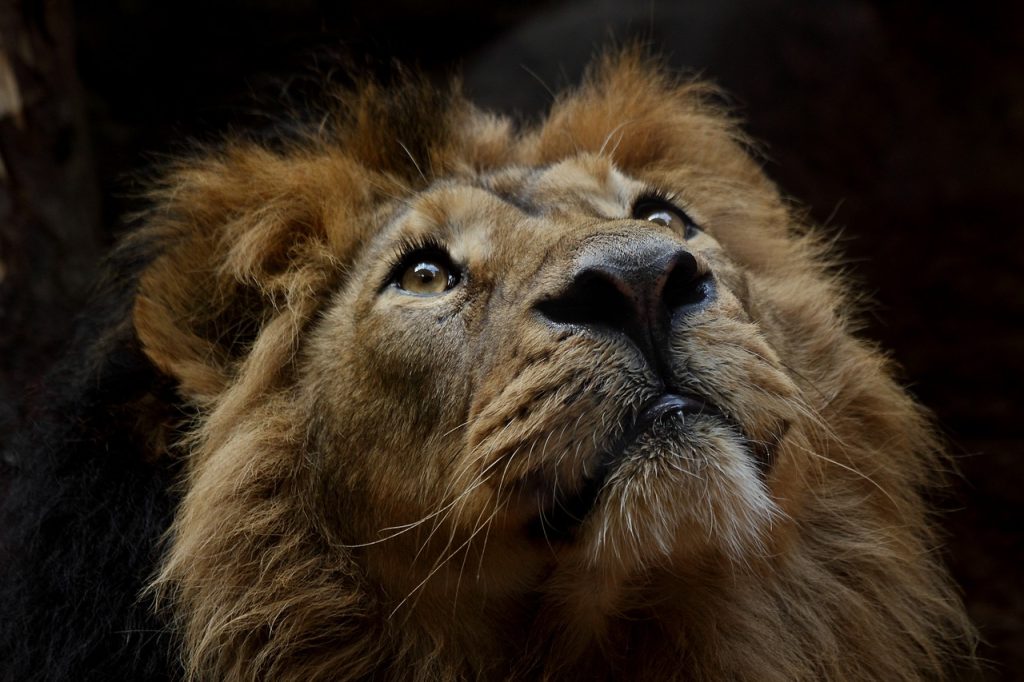
Quantities of Food Consumed
Daily Food Requirements
Lions have high energy demands due to their large size and active nature. On average, an adult lion requires approximately 5-7 kilograms (11-15 pounds) of meat per day to meet its nutritional needs. This amount may vary depending on factors such as age, sex, and individual size.
The daily food requirement ensures that lions have enough energy to sustain their activities, including hunting, patrolling their territories, and maintaining social bonds within the pride.
Feeding Frequency
Lions usually feed every 3-4 days when a successful hunt is made. Since they have the ability to consume large quantities of food in one sitting, they can go for extended periods without feeding. This adaptation is crucial for their survival in environments where prey availability fluctuates.
The ability to withstand periods without food also enables lions to conserve energy and avoid exposing themselves to unnecessary risks. It allows them to remain in their territories and wait for the opportune moment to engage in hunting activities.
Individual vs Group Meals
While lions typically feed as a group, they may also consume food individually. This occurs when there is an abundance of prey, and each member of the pride is able to secure their own meal. In such cases, lions may choose to separate and enjoy their food in solitude.
Individual meals provide lions with the opportunity to fulfill their specific dietary needs and consume sufficient amounts of meat. This flexibility in feeding behavior helps maintain the health and wellbeing of individual lions within the pride.
Scavenging Behavior
Feeding on Carcasses
Despite being proficient hunters, lions also exhibit scavenging behavior. They frequently scavenge on carcasses left behind by other predators or scavengers. This scavenging behavior allows them to capitalize on a readily available food source without the need for an active hunt.
When scavenging, lions may encounter partially consumed carcasses or the remains of animals killed by other predators. They opportunistically feed on these carcasses to supplement their diet and ensure their nutritional requirements are met.
Interaction with Other Scavengers
Scavenging behavior often leads to interactions between lions and other scavengers such as hyenas and vultures. These interactions can be both cooperative and competitive, depending on the circumstances.
Cooperative interactions may occur when multiple scavengers come across a carcass simultaneously. In such cases, lions and other scavengers may tolerate each other’s presence and feed alongside each other. This cooperative behavior allows lions to benefit from the scavenged food without expending energy on hunting.
However, competition for carcasses can also arise among different scavengers. Lions must assert their dominance and defend their share of the food from potential competitors. These interactions can be intense and may involve physical confrontations or vocal displays.
Benefits and Drawbacks
Scavenging behavior offers several benefits to lions. It provides an additional food source when hunting is not successful or during periods of food scarcity. Scavenging also allows lions to conserve energy and avoid risking injury or expending unnecessary energy on a difficult hunt.
However, there are also drawbacks to scavenging. Relying too heavily on scavenged food may hinder the development of essential hunting skills in younger lions. It may also make them dependent on the presence of other predators or scavengers to locate carcasses, potentially limiting their ability to survive independently in the long term.
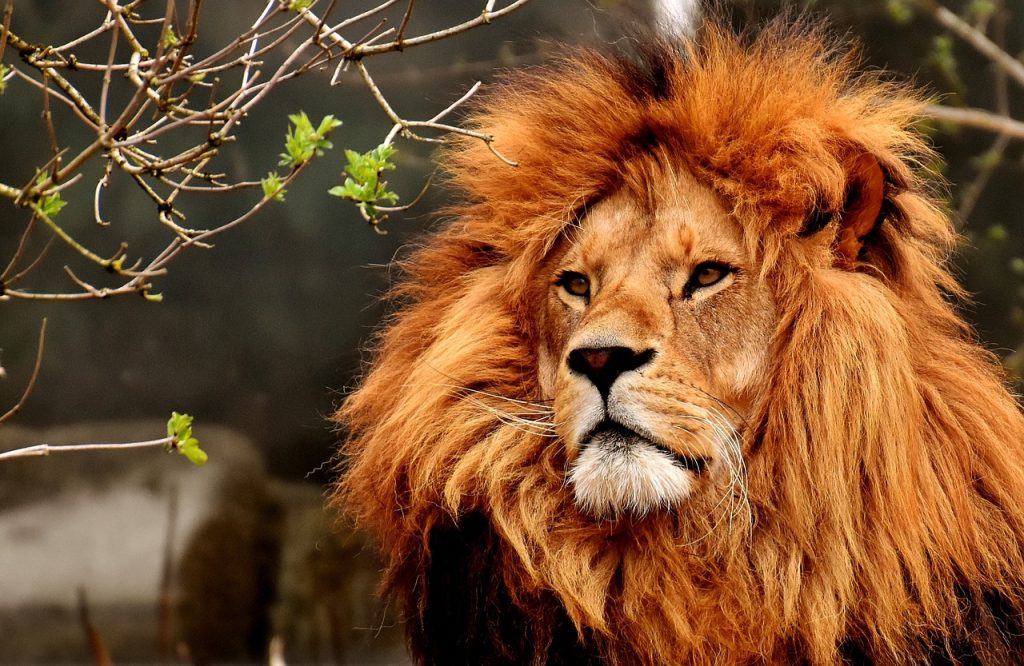
Factors Affecting Feeding Behavior
Availability of Prey
The availability of prey greatly influences the feeding behavior of lions. In areas with an abundance of suitable prey, lions may have more frequent and successful hunts, leading to regular feeding opportunities. Conversely, in regions where prey is scarce, lions may need to adapt their feeding strategies and rely more heavily on scavenging or individual prey encounters.
Changes in prey populations or migrations can also impact the feeding behavior of lions. They may need to adjust their hunting strategies and target different prey species to ensure their survival.
Seasonal Variations
Seasonal variations can have a significant impact on the feeding behavior of lions. In many African savannahs, rainfall patterns determine the movement of prey species, which in turn affects the hunting success of lions.
During the dry season, prey animals congregate around limited water sources, making them easier targets for predation. Lions take advantage of these predictable patterns and adjust their hunting strategies accordingly.
In contrast, during the wet season, the abundance of water and vegetation spreads out the prey populations, making hunting more challenging. Lions may need to cover larger areas in search of prey, altering their feeding behavior and strategies accordingly.
Competition from Other Predators
Competition from other predators can also influence the feeding behavior of lions. In areas where lions share their habitats with other large carnivores such as hyenas or leopards, competition over prey can be intense.
Lions must often compete for resources and assert their dominance to secure their share of the food. This competition may impact the feeding efficiency of lions and require them to be more strategic and adaptive in their hunting and scavenging behaviors.
Digestive System of Lions
Carnivorous Adaptations
Lions have a highly specialized digestive system adapted for a carnivorous diet. Their teeth are designed for cutting and tearing meat, while their jaws and muscles provide the strength necessary to overpower and kill prey.
Their short, muscular digestive tract allows for rapid digestion of meat, ensuring efficient absorption of nutrients. The presence of sharp, backward-facing premolars and molars aids in grinding bone, enabling them to extract every bit of nutrition from their prey.
Efficient Digestion
The digestive system of lions is optimized for efficient digestion of meat. Their stomachs have a highly acidic environment, which aids in breaking down proteins. The acidic conditions also help prevent the growth of harmful bacteria that may be present in the consumed meat.
The liver and pancreas produce enzymes that further assist in the digestion and absorption of nutrients. This efficient digestive process allows lions to extract maximum energy from their prey, ensuring their survival in harsh and unpredictable environments.
Challenges of Large Prey
While lions are adapted to consume large prey, there are challenges associated with hunting and eating such animals. Bringing down a massive herbivore requires strength, teamwork, and precise execution. Lions must avoid the defenses of their prey, such as sharp horns or hooves, while delivering a fatal bite.
After a successful kill, consuming a large prey animal presents logistical challenges. Lions must tear through tough skin and thick muscles to access the highly nutritious internal organs and meat. This requires considerable effort and coordination among pride members.
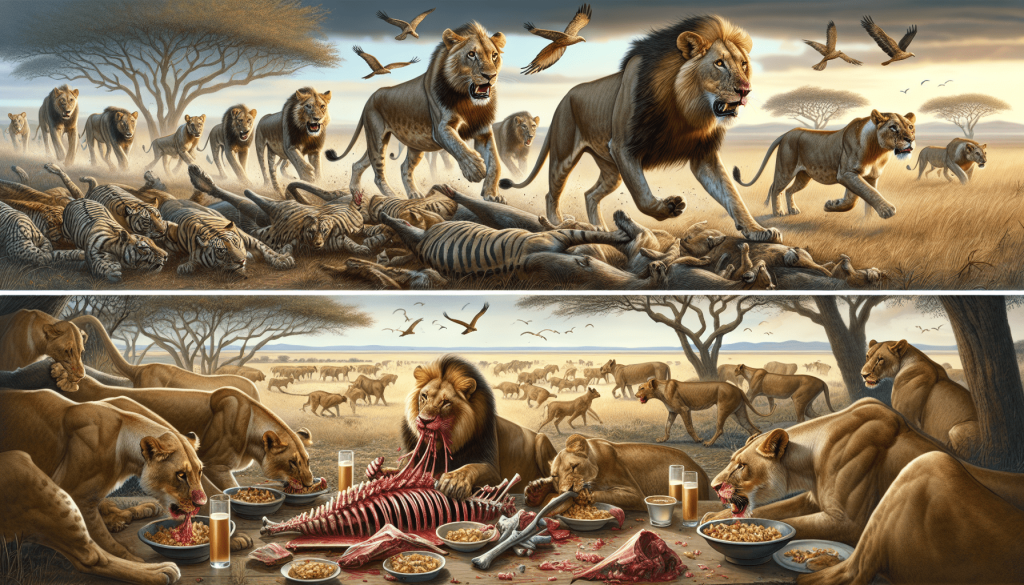
Conservation Considerations
Impact of Poaching
Poaching poses a significant threat to lion populations and their feeding behavior. Illegal hunting for trophy purposes or bushmeat trade reduces the number of prey species available, potentially leading to food scarcity for lions.
The loss of lions as a result of poaching disrupts their social structure and feeding hierarchy. It can lead to increased competition over prey and potentially impact their long-term survival.
Habitat Loss and Fragmentation
Habitat loss and fragmentation are major conservation concerns for lions. As human populations expand and encroach upon lion habitats, natural prey populations decline, making it more challenging for lions to find sufficient food.
Habitat fragmentation also disrupts the movement and hunting patterns of lions, further exacerbating the impact on their feeding behavior. It is vital to safeguard their natural habitats and ensure the availability of suitable prey species to maintain healthy lion populations.
Effects on Lion Feeding Behavior
The decline in prey populations and habitat loss have profound effects on lion feeding behavior. Lions may have to rely more heavily on scavenging or alter their hunting strategies to adapt to changing circumstances.
Food scarcity can lead to increased competition among pride members, potentially leading to conflicts and reduced breeding success. Disruptions in social dynamics and feeding hierarchy may have long-lasting consequences for the overall health and stability of lion populations.
Efforts to conserve lion populations should involve protecting their natural habitats, addressing poaching, and implementing sustainable management practices to ensure a healthy prey base for these iconic predators. By safeguarding their feeding behavior and ecological relationships, we can contribute to the long-term survival of lions in the wild.

